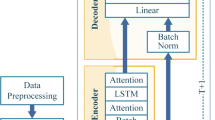Abstract
Gale weather can easily cause high-speed train accidents such as derailment and rollover. Therefore, the ultra-short-term prediction of wind speed is of great significance for a safe operation of high-speed rail. A prediction model based on long short-term memory (LSTM) networks and convolutional neural network (CNN) is proposed in this paper. The maximum wind speed data per minute collected by WindLog wind speed sensor is pre-processed. Setting includes reasonable step parameters and convolution kernel to establish a prediction model combined with two-layer LSTM and two-layer CNN. The proposed model was tested using wind speed data of Haidian District, and the wind speeds of 1 min, 5 min and 10 min ahead were predicted. The mean absolute error (MAE) of 1 min ahead prediction was 0.487 m/s. The MAE of 5 min ahead prediction is 0.547 m/s. The MAE of 10 min ahead prediction is 0.593 m/s. The predicting performances of different models are compared by using the same data. The experimental results show that the proposed prediction model has better adaptability and higher prediction accuracy.











Similar content being viewed by others
References
Asghar AB, Liu XD (2018) Estimation of wind speed probability distribution and wind energy potential using adaptive neuro-fuzzy methodology. Neurocomputing 287:58–67
Bandarathilake HMDP (2018) Rathnamali Palamakumbura, a stochastic differential equation based wind speed forecasting model. ICSBE:227–238
Cui XQ, Zhou XL, Fu J, Dai J, Liu J (2016) Research on level standards of high-impact weather over high-speed railway safety operation. J Catastrophol 31(03):26–30
Gong XL, Kong LS, Yuan CL, Xiao HQ (2017) Nonlinear time series prediction model based on particle swarm optimization B-spline network. J Electronic Measurement Instrumentation 31(12):1890–1895
Graves A (2012) Long short-term memory. Berlin: Springer 2018:1735–1780
He K, Li X (2018) Wind speed forcasting based on EEMD-GA-BP. Electron Meas Technol 41(08):146–149
Jing HL, Zhou YP, Jiang XY (2017) Forecasting of electricity consumption based on grey correlation analysis and the BP algorithm. Foreign Electron Meas Technol 36(12):109–112
Khosravi A, Machado L, Nunes RO (2018) Time-series prediction of wind speed using machine learning algorithms: a case study Osorio wind farm. Brazil ApplEnergy 224:550–566
Li F, Chen Y, Xiang W, Wang JX, Tang BP (2018) State degradation trend prediction based on quantum weighted long short-term memory neural network. Chin J Sci Instrum 39(07):217–225
Liu H, Mi XW, Li YF (2018) Smart deep learning based wind speed prediction model using wavelet packet decomposition, convolutional neural network and convolutional long short term memory network. Energy Convers Manag 166:120–131
Liu XJ, Cen TY, Zheng WS, Mi ZQ (2014) Neural network wind speed prediction based on fuzzy rough set and improved clustering. Proceed CSEE 34(19):3162–3169
Madhiarasan M, Deepa SN (2016) Comparative analysis on hidden neurons estimation in multi layer perceptron neural networks for wind speed forecasting. Artif Intell Rev 48(4):1–23
Moreno SR, Santos-Coelho L (2018) Wind speed forecasting approach based on singular Spectrum analysis and adaptive neuro fuzzy inference system. Renew Energy 126:736–754
Pinson P, Nielsen NA, Moller JK, Madsen H (2017) Non-parametric probabilistic forecasts of wind power: required properties and evaluation. Wind Energy 10(6):497–516
Qin J, Wang JP, Zhang CW (2012) Short-term wind speed forecasting based on wavelet neural network of phase space reconstruction. J Electron Meas Instrum 26(03):236–241
Ren C, An N, Wang JZ, Li L, Hu B, Shang D (2014) Optimal parameters selection for BP neural network based on particle swarm optimization: a case study of wind speed forecasting. Knowl-Based Syst 56:226–239
Ren ZS, Xu YG, Wang LL, Qiu YZ (2006) Study on the running safety of high-speed train under strong cross winds. J China Railway Soc 28(6):46–50
Srivastava N, Hinton G, Krizhevsky A, Sutskever I, Salakhutdinov R (2014) Dropout: a simple way to prevent neural networks from overfitting. J Mach Learn Res 15(1):1929–1958
Sugimotoa S, Nakakitab E, Ikebuchic S (2001) A stochastic approach to short-term rainfall prediction using a physically based conceptual rainfall model. J Hydrol 242:137–155
Tasnim S, Rahman A, Oo AMT, Haque ME (2018) Wind power prediction in new stations based on knowledge of existing stations: a cluster based multi source domain adaptation approach. Knowl-Based Syst 145:15–24
Torres-Barrán A, Alonso Á, Dorronsoro JR (2017) Regression tree ensembles for wind energy and solar radiation prediction. Neurocomputing
Xu XB, Yao Y, Wang JP (2013) Short-term wind speed forecast based on wavelet process neural network. J Electron Meas Instrum 27(10):944–950
Ye RL, Guo ZZ, Liu RY, Liu JN (2017) Wind speed and wind power forecasting method based on wavelet packet decomposition and improved Elman neural network. Trans China Electrotechn Soc 32(21):103–111
Zheng X, Wang YZ, Yuan ZX, Qin F (2018) Sentiment analysis of micro-blog short text based on convolutional memory neural network. J Electron Meas Instrum 32(03):195–200
Funding
This research was funded by the Fundamental Research Funds for the Central Universities of China (2019JBM045).
Author information
Authors and Affiliations
Corresponding author
Ethics declarations
Conflict of interest
Author Xining Xu and Author Yuzhou Wei declare that they have no conflict of interest.
Additional information
Publisher’s note
Springer Nature remains neutral with regard to jurisdictional claims in published maps and institutional affiliations.
Rights and permissions
About this article
Cite this article
Xu, X., Wei, Y. An ultra-short-term wind speed prediction model using LSTM and CNN. Multimed Tools Appl 81, 10819–10837 (2022). https://doi.org/10.1007/s11042-022-12215-5
Received:
Revised:
Accepted:
Published:
Issue Date:
DOI: https://doi.org/10.1007/s11042-022-12215-5




